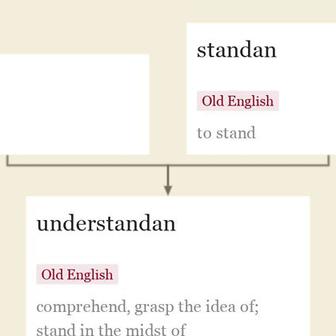understandable (adj.)
14世纪后期,“能够理解”; 15世纪后期,“能够被理解”,源自 understand 和 -able。相关词汇: Understandably。
understandable 的相关词汇
英语形容词的常见词尾和构词元素(通常基于动词),通常添加“能够; 允许; 值得; 需要; 被______ed”的概念,有时是“充满,引起”的意思,来自法语 -able 和直接来自拉丁语 -abilis。它正确的形式是 -ble,来自拉丁语 -bilis(元音通常来自被后缀的动词的词干结尾),它代表了 PIE 的 *-tro-,一个用于形成工具名词的后缀,与英语 rudder 和 saddle(名词)的第二个音节同源。
在英语中是一个活生生的元素,用于新的构词形式,无论是来自拉丁语还是本土词汇(readable, bearable),也与名词一起使用(objectionable, peaceable)。有时具有积极的意义(suitable, capable),有时具有中性的意义(durable, conformable)。它的意义变得非常灵活,例如一个 reliable witness,一个 playable foul ball, perishable goods。17世纪的作家有一个 cadaverable “致命的”。
To take a single example in detail, no-one but a competent philologist can tell whether reasonable comes from the verb or the noun reason, nor whether its original sense was that can be reasoned out, or that can reason, or that can be reasoned with, or that has reason, or that listens to reason, or that is consistent with reason; the ordinary man knows only that it can now mean any of these, & justifiably bases on these & similar facts a generous view of the termination's capabilities; credible meaning for him worthy of credence, why should not reliable & dependable mean worthy of reliance & dependence? [Fowler]
以一个具体的例子来说明,只有一个能干的语言学家才能告诉我们 reasonable 是来自动词还是名词 reason,它最初的意义是可以推理出来的,还是可以推理的,还是可以被推理说服的,还是有理智的,还是听取理由的,还是符合理性的; 普通人只知道它现在可以意味着任何一个,因此合理地认为这个词尾的能力是广泛的; 对他来说, credible 的意思是值得信任的,为什么 reliable 和 dependable 不能意味着值得依赖和信任?[福勒]
在拉丁语中, -abilis 和 -ibilis 取决于动词的屈折元音。因此,在古法语、西班牙语、英语中有变体形式 -ible。在英语中, -able 倾向于与本土(和其他非拉丁语)词汇一起使用, -ible 则与明显的拉丁语起源的词汇一起使用(但也有例外)。这个拉丁语后缀在词源上与 able 没有关联,但它长期以来一直与之相关联,这可能有助于它作为一个活生生的后缀的活力。

古英语单词 understandan 的意思为:“理解,领会,从词语或标志中接收旨意; 从一定角度看待某事”的意思,可能字面意思是“处于中间”,来自于 under 和 standan “站立”的结合(见 stand (v.))。
如果是这样的话, under 不是正常意义上的“在下方”,而是来自于古英语 under,它源于 PIE(欧洲原始语言)*nter- 的“在中间,之间,“这一意思(源头包括梵语 antar “在……间,之间”,拉丁语 inter “在……间,之间”,希腊语 entera “肠,内脏”; 见 inter-)。 相关的: Understood; understanding。
这是 Barnhart 给出的解释,但其他来源将古英语前缀和介词 under 的“在……之间,之中,在……之前,在……面前”的意思视为同一单词的另一种意思。在许多类似 understand 的古英语复合词中,似乎是“之间”的意思,例如 underniman “接收”, undersecan “检查、调查、详查”(字面上是“向下寻找”), underðencan “考虑,改变主意”, underginnan “开始”。
在表达方式仍然是“among”的表达式中,看起来也是这个意思,如 under such circumstances。也许最终的意思是“靠近”,可以与希腊语 epistamai “我知道怎么做,我懂”,字面意思是“我站在上面”相比较。
类似的构词法也在古弗里西语(understonda)和中古丹麦语(understande)中发现,而其他日耳曼语使用的是意为“站在之前”的复合词(德语 verstehen,在古英语中用 forstanden 表示“理解”,同时也表示“反对,抵制”)。对于这个概念,大多数印欧语系语言使用的是比喻扩展词缀,这些词缀字面上的意思是“放在一起”“分开”,“掌握,理解”(见 comprehend)。
中古英语中 understand 的拼写范围(如 understont, understounde, unþurstonde, onderstonde, hunderstonde, oundyrston, wonderstande, urdenstonden 等)也许反映出对复合要素的早期混淆。古英语 oferstandan,中古英语 overstonden,字面上是“超越,胜过”,似乎只用于字面意义。
到14世纪中期,它已经变为“假定为某事物的意味或暗示; 意味着; 推断; 假定为已知”。还有不及物的意思,“拥有智力能力; 成为一个聪明有意识的存在”,它在古英语后期也是如此。在中古英语中,还有“反思,沉思,想象; 对……持怀疑态度; 注意,注意到; 努力; 计划,打算; 构思(一个孩子)”的意思。有时也是字面意思,“占据下层空间”(14世纪后期),也是比喻性的,“提交”。在物理意义上,“站在下方”的古英语单词是 undergestandan。